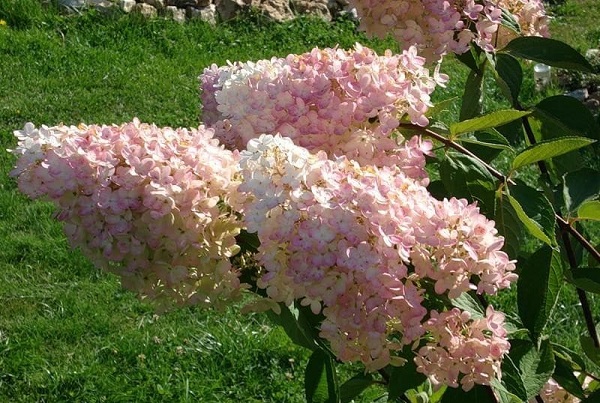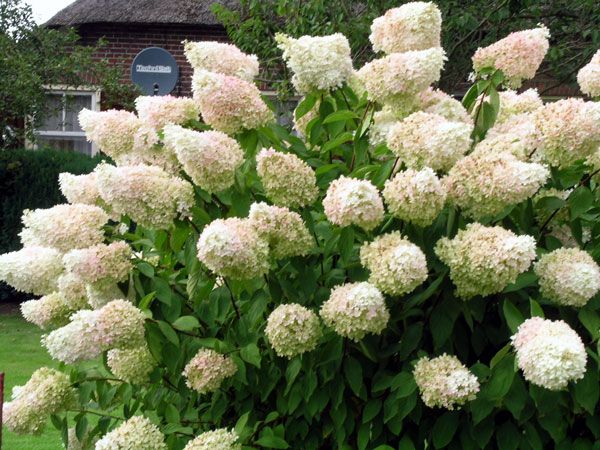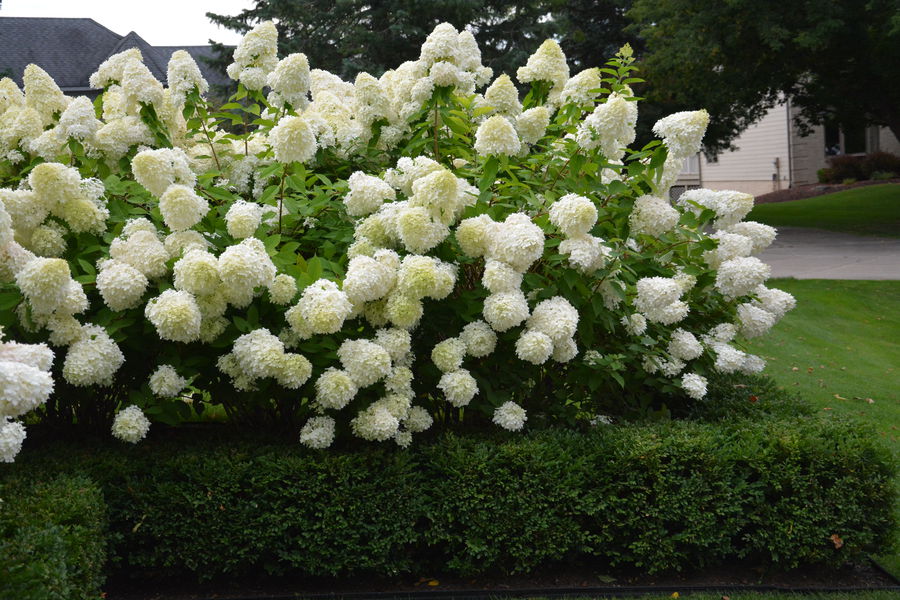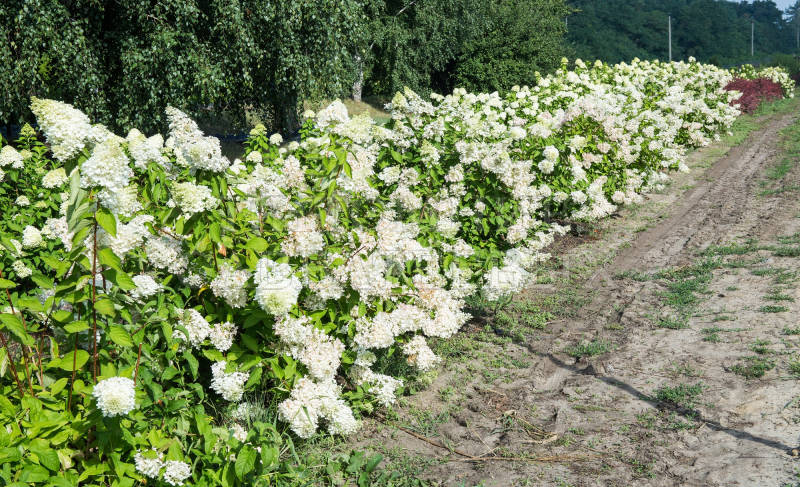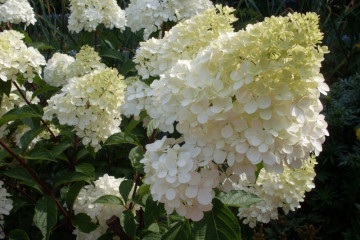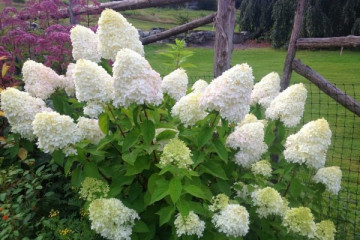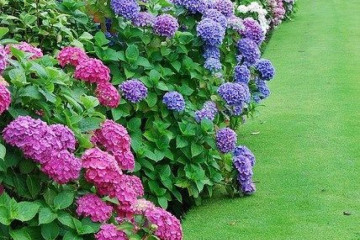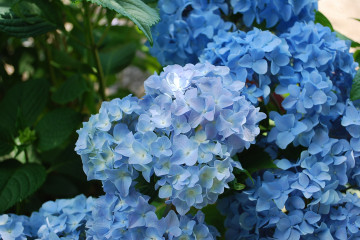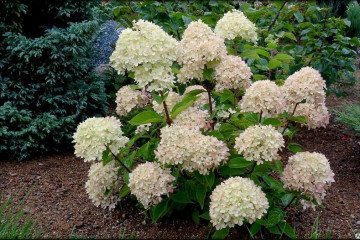Hydrangea paniculata Grandiflora (Grandiflora) - description
Hydrangea paniculata Grandiflora (in Latin the name sounds like Hydrangea paniculata ‘Grandiflora’) is a beautiful large-flowered shrub that is used for landscaping parks, cities and private sectors / summer cottages. She has been popular for a long time. The first memories of this plant date back to 1860. Then the hydrangea was much larger and could reach 10 meters in height. Modern varieties are smaller.
What is remarkable about the hydrangea paniculata Grandiflora, planting and caring for this plant in the open field what features do they have? How does the plant reproduce? What do you need to plant it?
Description of hydrangea Grandiflora
There are two main types of hydrangea: paniculate and tree-like. What is the difference between them?
Hydrangea paniculata appearance
It looks more like a shrub, tolerates severe frosts down to -30 degrees. Therefore, it can be grown even in the Urals. Native hydrangea paniculata Grandiflora from East Asia.
Modern varieties reach a height of 2 meters; during the flowering period, the width of the shrub is 3 meters. The plant is deciduous. The flowering period is from early June to September. Small flowers are combined into pyramidal inflorescences 30 centimeters in length. The size of the sheets is up to 12 centimeters. Fruits are not formed, Grandiflora panicle hydrangea is usually sterile.
The flowers are creamy at the beginning, which then turns to white. As the plant develops, they acquire a pink tint, at the end of flowering, the buds are painted in greenish-red tones. Fully hydrangea blooms only for 4-5 years.
Hydrangea tree appearance
Hydrangea tree-like outwardly resembles a tree (hence the name). This is a key difference from paniculata.
The panicle forms panicle-shaped inflorescences, while the flowers of the tree hydrangea are simpler.
Transplant after purchase in open ground
What is needed for landing
In order to perform a high-quality transplant, you need to stock up on sod land, peat, compost and earth. You need to make a substrate of them by mixing these components in a 2: 2: 1: 1 ratio.
Optimal location
Almost any ornamental plant does not like direct sunlight. Therefore, you need to look for a place that receives a sufficient amount of scattered light. The soil must be nutritious and have a neutral or acidic environment.
The plant is planted in spring or autumn. If several bushes are planted, a distance of 2-2.5 meters must be left between them.
Step-by-step planting process
- A round pit is pulled out with a diameter and depth of 50 centimeters.
- The substrate is poured, after which it is necessary to wait a week for it to compact a little.
- A seedling is pulled out of the container in which it was sold and placed exactly in the center of the pit. At the same time, the earthy ball must be preserved.
- The soil is lightly compacted.
After completing these actions, the plant needs to be watered.
Propagation of hydrangea paniculata Grandiflora
There are two ways to propagate the Grandiflora hydrangea: vegetatively and using seeds. At home, only the first method is possible. The most common option is propagation by cuttings, there are several more methods.
Cuttings
There are several ways how the Grandiflora hydrangea reproduces vegetatively:
- Division of the bush. It is carried out in spring or autumn. In the first case, you need to divide the bush before the start of sap flow. A part of the shoot with the root is cut off from the plant and sits in another place.
- Cuttings. Carried out in the summer. At this time, the tops of the shoots of the hydrangea are cut off and planted in the shade. Cover the cuttings with a glass container to protect them. It is important to provide them with regular watering and a constant flow of air. As soon as the cuttings take root, they need to be planted in the ground.
- Layers. First, you need to clean the lower branches from the foliage and lay them in the previously created furrows. Then they are covered with soil and watered. Then you need to wait until the root system is formed, and you can dig out the branches and transplant.
Growing from seeds
Seed propagation is almost never used at home due to the laboriousness of this process. Also, vegetative propagation takes less time, making it more profitable than growing seeds.
Care
If you do not care for hydrangea, it can lose its decorative properties. Therefore, it is important to pay special attention to watering, feeding and preparing for the winter.
Watering mode
Despite the fact that this variety is able to withstand an arid climate for a long time, it is still recommended to moisturize it frequently. Then the inflorescences will retain their excellent appearance. Watering rate - 1.5-2 buckets of water every week. Moisturizing is carried out in the morning or in the evening.
If the summers are hot, it is recommended to increase the frequency of watering to 2-3 times a week. If there is a lot of rain in summer, it is necessary to reduce the intensity of manual moistening in order to avoid contamination of the soil with fungi.
Top dressing
Fertilization of the soil is carried out several times a season. Top dressing is necessary to achieve a splendid flowering. Different fertilizers should be used at different times:
- Spring. During this period, organic fertilizers provide the greatest benefit to the plant. One of the recipes is as follows: 1 part of mullein or bird droppings is diluted in 15 parts of water, after which the feeding is infused for 24 hours. This mixture should be watered with hydrangea. Each bush requires 2 buckets.
- The appearance of buds. Mix 20 grams of ammonium nitrate, 30 grams of superphosphate and 30 grams of potassium salt in 1 bucket of water.
- Summer. At this time, a specialized fertilizer for ornamental plants is applied.
- Fall. Mixed in 50 grams of superphosphate and potassium salt and applied under the bush. Such fertilization forms qualities in the plant that will help it survive severe frosts.
During flowering
During the flowering period, hydrangea grandiflora needs watering most of all. It is able to withstand long periods of drought, but this leads to a decrease in the number of inflorescences.
It is very important to add mineral compounds during flowering. Fertilization frequency is every two weeks. Organic formulations should be used every four weeks.
So you can achieve a longer flowering time of the shrub, in order to increase the quality, it is necessary to remove last year's shoots growing from one point. The only exception is if there are only two of them.
During the rest period
The dormant period for hydrangea occurs in winter. At this time, the plant is gaining strength to bloom beautifully in spring.There are no special rules for leaving. It is advisable to move the shrub to a place where the temperature will be maintained at 7-9 degrees Celsius (dig it out). Typically, this microclimate is maintained in the basement.
Preparing for winter
It is very important to move the hydrangea to a cool, but not frosty place. If this is not done, then it will not bloom for a whole year, and will be able to please with its beauty only next winter.
Thus, panicle hydrangea is a very beautiful ornamental shrub that can be used in any summer cottage in almost any climatic zone. The plant is not afraid of drought, but loves moisture. It is not very difficult to take care of these flowers, but they bloom for a long time, magnificently and beautifully.
